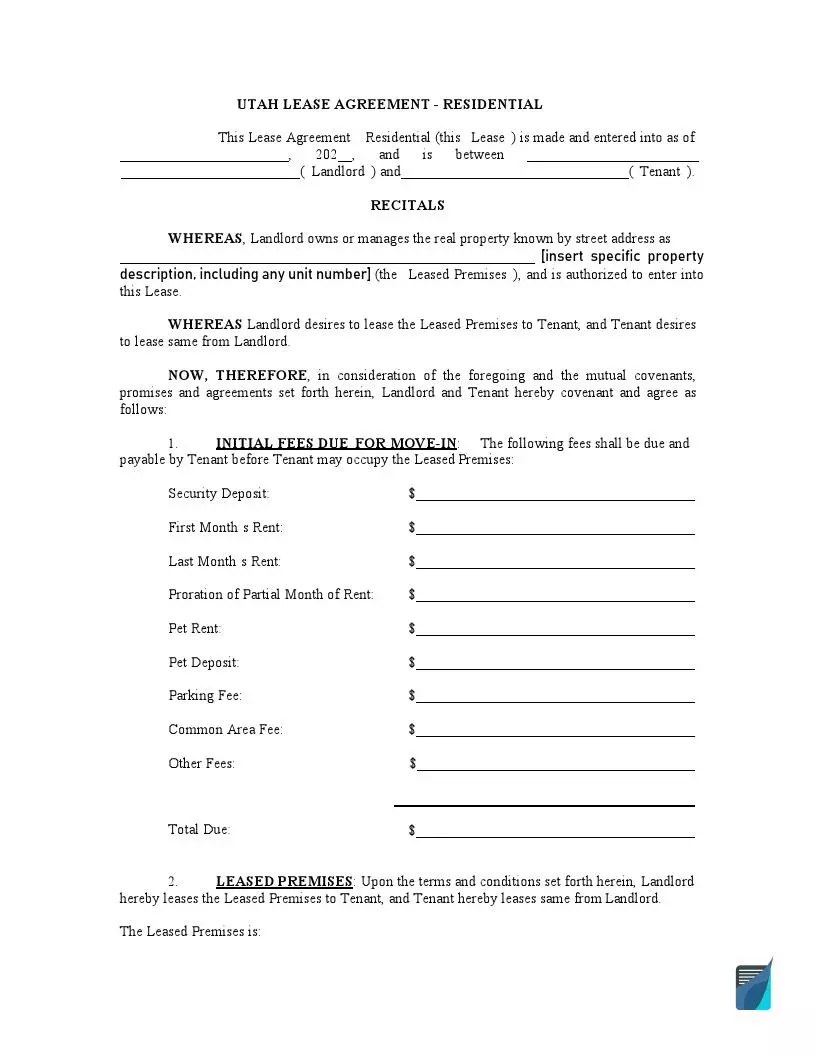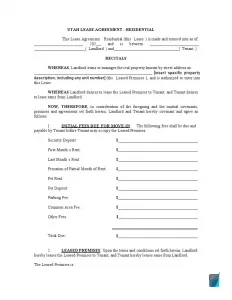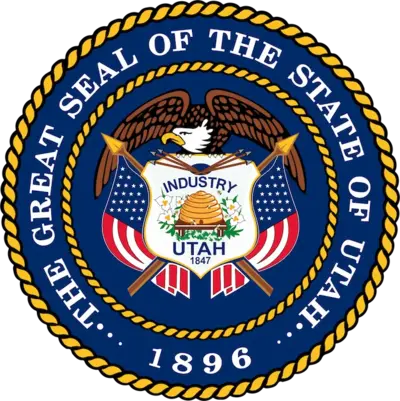Utah Rental Lease Agreement Forms
The fundamental function of any rental agreement is to provide security to the potential landlord and tenant, ensure mutual respect, habitable requirements, and maintain rental property safe, clean, and well-conditioned.
The state of Utah provides a series of protective measures stated in Chapter 22, Title 57 of the Utah Code. The object of any rental agreement is either a dwelling or commercial unit, which is leased by a tenant, usually in exchange for a particular amount of money called rent payment. Each participant of the deal acquires responsibilities and powers, which must be stated in black and white and certified by the parties’ signatures.
Generate a necessary form using our latest software to accomplish successful completion.
Relying on the purpose of a lease agreement Utah introduces the following templates:
- Month-to-Month Rental Contract
- Commercial Lease Contract
- Roommate Rental Agreement
- Termination Notice
- Sublease Contract
- Lease Agreement with Option to Acquire Property
- Standard Residential Lease Agreement

Build Your Document
Answer a few simple questions to make your document in minutes
Save and Print
Save progress and finish on any device, download and print anytime
Sign and Use
Your valid, lawyer-approved document is ready
Utah Laws and Lease Requirements
In the upcoming paragraphs, we intend to reveal some challenging issues that a lessor and lessee might face while entering into a deal. We listed the most prevalent topics so that you remain aware and prepared. However, if you feel that you might need legal assistance, it is advisable that you find a qualified state’s department or a lawyer who can provide reliable information on the matter.
Security Deposit
A security deposit provides extra protection to the landlord, who tries to maintain the property well-conditioned. Utah laws do not give any recommendation on how much the property owner can claim as a deposit. However, it is inherent to point out the amount of money requested.
When terminating the lease agreement, the landlord has 30 days to return the whole sum if the tenant has not damaged the property. Normal tear and wear issues cannot be considered corruption or destruction.
If the landlord or any authorized person acting on his or her behalf fails to satisfy the laws to return the deposit funds, the rentee can claim the money via a special form called “Tenant’s Notice to Provide Deposit Disposition” in the Code.
Following §57-17-2, the owner must accommodate the demands within five days after receiving the tenant’s letter.
Landlord Right of Entry
A lessor can claim the right to enter the rented property to provide improvements and sustain livable conditions to the property. Under §57-22-4 of the Utah Code, the landlord must notify the tenants at least 24 hours before the inspection.
Disclosures
- Identification of the landlord or an agent acting on his or her behalf. The property owner is obliged to provide the legal name, address, and any authorized person that can execute decisions on his or her behalf. These data should be disclosed and attached to the agreement.
- Move-in itemized list. The lessor must provide the lessee with an inspection list and allow checking the territories of the property on their own. This action should be achieved before authorizing the lease agreement with signatures.
- Disclosure of data about lead-based paint. The landlord must provide full information on the presence or absence of lead-based painting materials. This demand must be satisfied following the requirements of federal law.
Termination Notice
Utah laws introduce different requirements when notifying tenants about lease cancellation. These demands rely on different types of rental templates.
- Standard residential lease agreements and other types of contracts with a fixed rental period don’t expect any termination notification.
- Month-to-month agreements and contracts with no specified ending date demand a 15-day termination letter from the landlord.
There are several cases of termination based on various kinds of violations that we will cover in the upcoming section.
Popular Local Rental Lease Agreement Forms
- Oregon (OR) lease agreement guide
- Free Massachusetts lease agreement form and laws
- Legal Illinois rental lease agreement template
- Valid Ohio (OH) lease agreement and guide
- Fillable Maryland rental agreement template PDF
- MI rental agreement sample
- California lease agreement template
- New Mexico (NM) lease agreement form
Eviction Terms
Utah’s laws define several violations of the agreement that can lead to a non-planned eviction.
- Failure to provide rental payment. This case is the most facile out of the three issues. Suppose the tenant fails to pay the rent on time. The landlord may serve a three-day termination letter for nonpayment. The lessee must either pay the debt or vacate the residence. The tenant’s refusal to execute one of the described actions empowers the landlord to seek the authorities’ assistance.
- Violation of terms. If the tenant violates any terms (but the failure to provide a timely payment) of the contract, the landlord is empowered to send a three-day termination notice to cure the issue or leave the property. Any further violations on the lessee’s part will result in court issues.
- Illegal matters. Any type of illegal activity on the part of the tenant will result in vacating the property without a permit to fix the matter. The property owner should serve a three-day termination letter with demands to depart from the residence.
Utah Rental Lease Agreement Form Details
| Document Name | Utah Rental Lease Agreement Form |
| Other Names | UT Rental Lease, Utah Residential Lease Agreement |
| Relevant Laws | Utah Code, Title 57 |
| Security Deposit Amount | No limit |
| Security Deposit Return | Thirty (30) days from termination date |
| Avg. Time to Fill Out | 18 minutes |
| # of Fillable Fields | 119 |
| Available Formats | Adobe PDF |


We provide a multitude of key Utah templates to anyone looking for simplicity when dealing with various paperwork.
Other Rental Lease Agreement Forms by State
